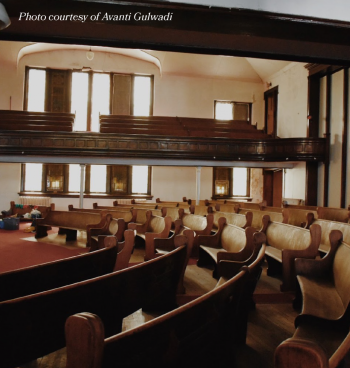Saving faith
Waterloo community members, organizations and UNI team up to preserve a historic Baptist church, and create meaningful programming.

What makes a church a sacred place?
Is it the physical four walls? A collective purpose? A space for spiritual gathering, respite, togetherness, healing?
These questions were pressing for a group of neighbors in the Walnut Neighborhood, adjacent to downtown Waterloo, as they watched the continued deterioration of the beloved Walnut Street Baptist Church.
The needs of the community were no less than when the current structure was built in 1908. It's Baptist congregation, one of the largest in Iowa, moved to a new structure in 1971 and the building was sold to Faith Temple Baptist Church. In 2000, the church was listed in the National Register of Historic Places and in 2010, it held its last service.
And there it sat, watching over the community in its little triangular lot.

In 2016, the community decided to do something about it.
The Iowa Heartland Habitat for Humanity purchased the historic church, on behalf of the Walnut Neighborhood Development Coalition. "The plan was just to hold on to it for a bigger purpose, not knowing exactly who would be involved, or what it will look like, but knowing that the building is so special," said Angela Waseskuk, instructor in UNI's Department of Art.
Planning has since been underway on how to properly restore its iconic architecture and utilize the space mindfully by the neighborhood and surrounding communities, thanks to the guidance of key members from the coalition and the University of Northern Iowa.
Drew Conrad, ‘93, Karla Organist and the team at UNI’s Institute for Decision Making (IDM) have been integral to the process. Thanks to their oversight, alongside funding from the Office of the Provost, the coalition has been able to recently hire a community consultant with strong ties to North Waterloo. Matthew Gilbert will now lead the charge of gathering input from Waterloo residents, with help from local organizers like Laura Hoy, from the Walnut Neighborhood Association, Ali Parrish, from the Iowa Heartland Habitat for Humanity and Sharina Sallis, corporate social responsibility manager from CUNA Mutual Group (among many others).
CSBS professors Gowri Betrabet Gulwadi and Gary Gute are also a key part of the planning committee. As coordinator of UNI’s interior design program, Betrabet Gulwadi is enthusiastic about the possibilities of the beautiful space and potential for future student projects and participation.
With the help of local architects, who were able to supply the church’s original plans, students have thus far been working towards creating a 3D model in REVIT to help conceptualize the revitalization. But the possibilities for student participation and programming support only grow from here

“It's such a big part of our students’ learning experiences,” said Gute. “To learn about the history and culture and community right where they're learning it? This is our role as educators; to help co-create with students lived experiences where they can learn and grow.”
Beyond this connection to UNI, the team is quick to point out that the main focus has and will always tie back to the community. “All the way through the strong thread has been, ‘We want to know what the community wants,’” remarked Betrabet Gulwadi. "We want this to be for the community, by the community.”
And as director of the Human Potential Project and UNIFlowLab, Gute remarked on how beautifully the project has come together, and the excitement for what’s to come. “We want to do what we can with the expertise we have. Help bring together all of the people within these multiple systems of the community to do really remarkable things that can be continued for generations to come.”
